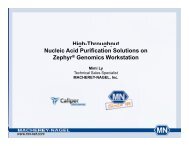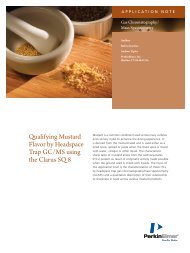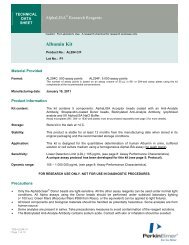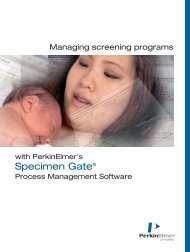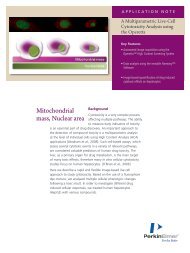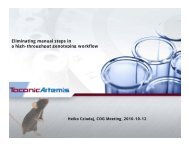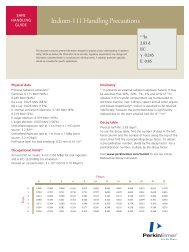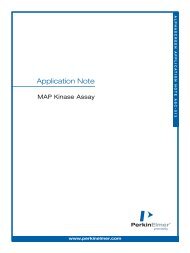Immunogenicity Assessment Using the AlphaLISA ... - PerkinElmer
Immunogenicity Assessment Using the AlphaLISA ... - PerkinElmer
Immunogenicity Assessment Using the AlphaLISA ... - PerkinElmer
Create successful ePaper yourself
Turn your PDF publications into a flip-book with our unique Google optimized e-Paper software.
spiked with <strong>the</strong> drug at a final concentration of 25 μg/mL<br />
(spiked samples). The overall mean of PC and blank samples<br />
loaded on <strong>the</strong> plate and <strong>the</strong> individual lots of human serum<br />
analyzed for <strong>the</strong> CP determination on <strong>the</strong> same plate served<br />
as control unspiked samples. The spiked and unspiked<br />
samples were incubated for 1 hour at 23 ˚C and <strong>the</strong>n tested.<br />
The % signal inhibition was determined for each assay<br />
control and serum lot, using <strong>the</strong> following formula:<br />
% Signal Inhibition =<br />
[1-(spiked sample/control unspiked sample)] x 100<br />
For calculation of <strong>the</strong> drug competition test cut-point,<br />
normal distribution of <strong>the</strong> data was assumed. On each<br />
occasion, <strong>the</strong> % signal inhibition was calculated as outlined<br />
above for each individual lot tested. Then <strong>the</strong> mean and SD<br />
were computed using <strong>the</strong> % inhibition of all <strong>the</strong> individual<br />
lots tested on a particular occasion. The mean +2.33 x SD,<br />
which represents <strong>the</strong> 99th percentile of a normal distribution,<br />
was calculated for each occasion. All serum lots with<br />
values higher than <strong>the</strong> 99th percentile on at least 50% of<br />
<strong>the</strong> occasions were identified as outliers and removed from<br />
<strong>the</strong> drug competition test cut-point calculation. The mean<br />
+2.33 x SD value for each occasion was calculated again in<br />
<strong>the</strong> second iteration using <strong>the</strong> remaining individual serum<br />
lots. Finally, <strong>the</strong> fixed drug competition cut-point obtained<br />
on each occasion was averaged to obtain <strong>the</strong> final drug<br />
competition test cut-point.<br />
Acceptance Criteria<br />
The final drug concentration (25 μg/mL) should generate<br />
a reduction (% signal inhibition) higher than or equal to<br />
<strong>the</strong> CCP when comparing <strong>the</strong> mean relative counts of <strong>the</strong><br />
drug-spiked PC samples (LPC and HPC) to <strong>the</strong> corresponding<br />
mean relative counts of <strong>the</strong> unspiked PC samples. The final<br />
drug concentration (25 μg/mL) should generate a reduction<br />
(% signal inhibition) lower than <strong>the</strong> CCP when comparing<br />
<strong>the</strong> mean relative counts of <strong>the</strong> drug-spiked Blank to <strong>the</strong><br />
corresponding mean relative counts of <strong>the</strong> unspiked Blank.<br />
Table 2. Confirmatory cut-point. The CCP was determined<br />
using 50 individual lots of PNHS spiked with 25 μg/mL of<br />
<strong>the</strong> drug, analyzed each in duplicate on a total of four occasions.<br />
It was calculated as <strong>the</strong> mean of percentage inhibition<br />
plus +2.33 x SD. One sample was removed for <strong>the</strong> second<br />
iteration.<br />
1st iteration<br />
2nd iteration<br />
Confirmatory<br />
Confirmatory<br />
Cut-Point<br />
Cut-Point<br />
Mean 7.0 6.1<br />
n 50 49<br />
SD 10.5 8.4<br />
Cut-Point (counts) 31.5 25.7<br />
One human serum lot was identified as an outlier during <strong>the</strong><br />
screening cut-point determination and produced % signal<br />
inhibition values higher than <strong>the</strong> 99th percentile on <strong>the</strong> four<br />
occasions; <strong>the</strong>refore it was excluded from <strong>the</strong> CCP calculation.<br />
The mean CCP calculated as <strong>the</strong> average of all <strong>the</strong> CCP<br />
obtained from all occasions was defined at 25.7%. The LPC<br />
and HPC spiked with 25 μg/mL drug final concentration<br />
generated a % inhibition superior to <strong>the</strong> CCP. The blank<br />
spiked with 25 μg/mL drug final concentration generated<br />
a reduction lower than or equal to <strong>the</strong> CCP.<br />
Table 3. Controls for <strong>the</strong> CCP.<br />
Control results for <strong>the</strong> CCP<br />
Mean<br />
Status with<br />
Counts<br />
regards to<br />
Samples Spiked Unspiked % inhibition CCP<br />
LPC 590 1361 56.4 ≥ CCP<br />
HPC 9128 59928 84.4 ≥ CCP<br />
PHNS 469 451 -4.0 < CCP<br />
Both positive control samples showed percentage of inhibition<br />
higher than <strong>the</strong> CCP confirming that <strong>the</strong>se samples contain<br />
specific ADA.<br />
Assay Sensitivity and Prozone Effect<br />
The assay sensitivity is relative to <strong>the</strong> characteristics of <strong>the</strong><br />
positive controls used in <strong>the</strong> assay. In <strong>the</strong> present assay, <strong>the</strong><br />
affinity-purified goat anti-mouse IgG antibody (PC) was used<br />
to evaluate <strong>the</strong> sensitivity of <strong>the</strong> assay. The assay sensitivity<br />
was tested on six occasions, performed by two analysts<br />
using a balanced design, at <strong>the</strong> LPC concentration (15 ng/<br />
mL) prepared in PNHS. The assay sensitivity was evaluated<br />
based on <strong>the</strong> inter- and intra-assay precision results. Ano<strong>the</strong>r<br />
indicator of method sensitivity is <strong>the</strong> assay’s ability to detect<br />
approximately 5% false positives among <strong>the</strong> lots of human<br />
serum that were tested for CP determination and specificity<br />
assessment.<br />
Acceptance Criteria<br />
The sensitivity was defined as <strong>the</strong> lowest PC concentration<br />
meeting <strong>the</strong> acceptance criteria described later for <strong>the</strong> interand<br />
intra-assay precision. The lowest PC sample that met<br />
<strong>the</strong> acceptance criteria was selected for <strong>the</strong> samples analysis<br />
and subsequent qualification assays. It should be noted that<br />
drug tolerance and drug competition results may justify<br />
selecting an alternative PC level even if <strong>the</strong> LPC meets <strong>the</strong><br />
above mentioned criteria.<br />
4



